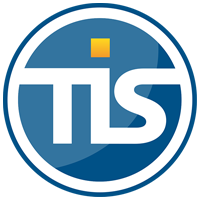How can Cash Management improve your Cash Conversion Cycle part III
| 07-10-2016 | Olivier Werlingshoff |
 This week an article about the underestimation of cash management on LinkedIn caught my attention. 50% of the companies even doesn’t see the added value of a good cash flow forecast! This does not surprise me and therefore gave me a reason to pick up the pen and write another article on how to improve your cash conversion cycle!
This week an article about the underestimation of cash management on LinkedIn caught my attention. 50% of the companies even doesn’t see the added value of a good cash flow forecast! This does not surprise me and therefore gave me a reason to pick up the pen and write another article on how to improve your cash conversion cycle!
In my two previous articles I gave some examples of how cash management could improve the DSO and the DIO but, what about the DPO? The DPO is an efficiency ratio that measures the average number of days a company takes to pay its suppliers. The more days, the better your cash conversion cycle will be.
Extend payment terms
The first action that can be taken is to extend your payment terms. In the payments barometer from Atradius of 2016 you can find an overview of all payment terms and average DSO for all countries in Western Europe. The reasons why payments are delayed are also mentioned.
The average given payment term to B2B customers in The Netherlands is 27 days, the average DSO is 42 days! Most of the time the first action that is taken when companies have liquidity problems is to extend their payments. The negative aspects of this action can be major. The first aspect is the impact this action has on your supplier, because he has to wait to receive his money. He will then have to look for alternative borrow possibilities. Besides the negative relationships, the extra costs will probably be include in his next price. Suppliers can also decide only to send you the goods when paid in advance.
As you can read this action can have a boomerang effect.
Reverse factoring
A possibility to extend your payment term without all negative effects is to use reverse factoring. With reverse factoring you give the possibility to your supplier to receive more favorable financial terms than they would have otherwise received for a loan.
The effect could be that the relationship between you and the supplier can be improved and you still can extend your payments.
Single payment solution
Another solution is to decrease your banking transfer time of a payment. If you have a lot of foreign suppliers, transfer times can easily be extended, especially when you need to use correspondent banks.
Using banks with an international presence as well as a single payment solution will facilitate you to follow your payment and use the fastest transfer method. By doing so, you can delay the moment of payment and still pay on time.
Within the EU you can make direct payments as a SEPA payment, because there are no borders anymore for money transfers. You don’t need local accounts anymore to facilitate and accelerate your payments.

Owner of WERFIAD
Waarom is er weinig interesse voor Cash Management?
| 06-10-2016 | Maarten Verheul |
 Overal waar ik binnen kwam waren er Cash problemen. Door simpelweg het Credit Management wat strakker aan te pakken was er binnen twee weken weer genoeg cash voor de korte termijn. Een aanmaningssessie en een telefoonronde is vaak al voldoende.
Overal waar ik binnen kwam waren er Cash problemen. Door simpelweg het Credit Management wat strakker aan te pakken was er binnen twee weken weer genoeg cash voor de korte termijn. Een aanmaningssessie en een telefoonronde is vaak al voldoende.
Voor de lange termijn zijn er vaak ook wel zaken te bedenken. Nog niet ingestuurde subsidie aanvragen en toch ook nog terug te ontvangen vennootschapsbelasting door middel van Carry Back, Buitenlandse BTW, oninbare BTW, Suppletie aangifte BTW.
Waarom besteden we meer tijd aan de Winst en Verliesrekening dan aan Cash? Kunt U morgen alle vervallen facturen betalen?
“Waarom besteedt slechts 10% van de bedrijven aandacht aan liquiditeitsprognose?” :
- Het bedrijf onderschat de waarde 53%
- Er is geen kennis in huis 21%
- Het management is niet geïnteresseerd 13%
- Het bedrijf heeft geen bankkrediet 5%
- Andere reden 8%
Mijn grootste hobby is Cash Management. In het verleden heb ik daar grote successen mee gehad en bedrijven mee gered. Ik heb de salarissen nooit één dag te laat betaald, omdat ik wist hoe de vlag van de Cash er voor stond. Als je weet hoe de vlag er voor staat, dan pas kun je keuzes maken. Als je het niet weet dan is er geen keuze meer. Of u stuurt de betalingen in naar de bank en de bank belt dat ze niet worden uitgevoerd. Dan wordt het pas echt gezellig, want de volgende dag belt de bank weer dat u bij Bijzonder Beheer van de bank komt.
De kern van het probleem is volgens mij dat Cash niet als sexy ervaren wordt. Het lijkt zo banaal en helemaal terug tot de elementen. Men zegt liever: “Ik ben business controller.”. Toch is de Cash-positie en -planning wel één van de meest elementaire zaken die binnen een onderneming goed geregeld moeten zijn.
[separator type=”” size=”” icon=””]
 Maarten Verheul – Treasury Consultant
Maarten Verheul – Treasury Consultant
[button url=”https://www.treasuryxl.com/community/experts/maarten-verheul/” text=”View expert profile” size=”” type=”primary” icon=”” external=”1″]
Five points to consider when choosing your payment system
| 05-10-2016 | TIS | Sponsored content |

The payment processes in corporations and internationally active companies are more complex than you might think at first glance – and they are unclear and non-transparent virtually everywhere. This complexity results from the branched company structure and the consequent variety of banking arrangements maintained at central HQ and out in the branch offices and subsidiaries. Various currencies, formats and security keys present an obstacle to unitary, standardized payment processes and an overall view of bank transactions.
Intelligent payment systems in the cloud can remedy this situation: they improve transparency over payment processes, reduce costs and risks and form the basis for better company decision-making. In the typical scenario of an internationally active company they easily contribute annual savings of one million euros.
Download the executive briefing.
Uitgelicht: Staatsschuld
| 04-10-2016 | Lionel Pavey |
 Het ziet er goed uit in Nederland; financieringsbehoefte voor 2016 valt EUR 9 miljard lager uit dan verwacht; begrotingstekort in 2017 naar EUR 3 miljard – een verbetering van EUR 5 miljard ten opzicht van 2016; rentelasten in 2017 EUR 1,4 miljard minder dan in 2016; de staatsschuld daalt naar 62% van het bbp. Van de andere kant komen de volgende feiten; de staatsschuld is opgelopen van circa EUR 250 miljard in 2006 tot ongeveer EUR 440 miljard in 2016; de lasten zijn omhoog gegaan (BTW verhoogd) terwijl de uitgaven zijn verminderd; sinds 2009 zijn de overheidsuitgaven bijna onveranderd terwijl de staatsschuld is opgelopen.
Het ziet er goed uit in Nederland; financieringsbehoefte voor 2016 valt EUR 9 miljard lager uit dan verwacht; begrotingstekort in 2017 naar EUR 3 miljard – een verbetering van EUR 5 miljard ten opzicht van 2016; rentelasten in 2017 EUR 1,4 miljard minder dan in 2016; de staatsschuld daalt naar 62% van het bbp. Van de andere kant komen de volgende feiten; de staatsschuld is opgelopen van circa EUR 250 miljard in 2006 tot ongeveer EUR 440 miljard in 2016; de lasten zijn omhoog gegaan (BTW verhoogd) terwijl de uitgaven zijn verminderd; sinds 2009 zijn de overheidsuitgaven bijna onveranderd terwijl de staatsschuld is opgelopen.
Nederland heeft meer dan EUR 300 miljard in uitstaande staatsobligaties. In de periode 2017 tot en met 2020 wordt er voor bijna EUR 150 miljard aan staatsleningen afgelost. Deze worden grotendeels vervangen door nieuwe staatsleningen. Dit zijn geen nieuwe investeringen in Nederland – het geld is al eerder uitgegeven.
Minister Dijsselbloem geeft aan dat Nederland moet investeren om de economische groei in Nederland aan te jagen, terwijl de overheid nog geen stimulerend beleid kan voeren. De huidige staatsschuld is een beroep op de toekomstige inkomsten van alle Nederlanders – vooral de jongere generatie. Dit impliceert dat er minder geld beschikbaar zal zijn voor investeringen die nodig zijn voor infrastructuur, onderwijs, enzovoorts.
In een normale economische cyclus zal de staatsschuld verminderd worden als een land niet meer in een recessie zit maar, gezien de omvang van de staatsschuld en de wens om te investeren in de toekomst, is het de vraag of Nederland daadwerkelijk de staatsschuld kan terugdringen.

Cash Management and Treasury Specialist – Flex Treasurer
Uitgelicht: Staat haalt in 12 minuten €1 mrd op met heropening staatsobligatie
| 03-10-2016 | Rob Söentken |


Ex-derivatives trader
Verzekering maximale Euribor rente
| 30-09-2016 | Erna Erkens |
 U kunt de zekerheid kopen dat u over uw variabele financiering nooit een hoger 1- maands Euribor tarief betaalt dan 0.25% (exclusief de opslag uiteraard). U blijft gewoon het 1 maands Euribor betalen zolang dit onder het 1 maands Euribor onder de 0.25% blijft.
U kunt de zekerheid kopen dat u over uw variabele financiering nooit een hoger 1- maands Euribor tarief betaalt dan 0.25% (exclusief de opslag uiteraard). U blijft gewoon het 1 maands Euribor betalen zolang dit onder het 1 maands Euribor onder de 0.25% blijft.
Heeft u een financiering bij een bank met een variabele, bijvoorbeeld 1 maands Euribor rente?
Dan denk ik dat het een goed idee is om een renteplafond (Rentecap) te kopen op deze Euribor rente. Ik heb de afgelopen tijd een aantal artikelen gelezen en hoe meer ik er over nadenk, hoe sterker mijn overtuiging wordt dat de rente sneller zal stijgen dan de markt nu in prijst. Dit is te zien in de platte rentecurve.
Dit is een grafiek van korte naar de lange rente. We bevinden ons, volgens mij, in een ongezonde rente situatie. De rente is historisch laag en er gebeurt niet wat de ECB hoopte dat er zou gebeuren. Namelijk inflatie en economisch herstel (dit is er dan wel mondjesmaat maar met veel bijwerkingen).
De negatieve effecten wegen volgens steeds meer mensen niet meer op tegen de positieve effecten. Er komen steeds meer meningen en overtuigingen dat dit zo niet door kan gaan en het borrelt. Misschien nu nog diep onder de grond, maar noem het vrouwelijke intuïtie, dit gaat volgens mij sneller veranderen dan waar de markt nu rekening mee houdt. Leest u Joseph Stiglitz en Bas Jacobs er maar eens op na. Stel dat Donald Trump president wordt op 8 november. Dan gaat de rente echt snel stijgen want hij is niet vies van verhoging van de overheidsuitgaven. En dat kost geld!
De korte (Euribor rente) en de lange bijvoorbeeld 5 en 10 jaars rente zijn heel laag. Daarom is de premie op voor het kopen van een renteplafond op het Euribor (1 of 3 maands bijvoorbeeld) nu relatief heel laag (=goedkoop). Dus u kunt voor (relatief) weinig geld zekerheid kopen van bijvoorbeeld een Euribor tarief van 0.25%. Dat is een mooi tarief en over 2 jaar ziet de wereld van de rente er volgens mij echt heel anders uit.
Hoe werkt de variabele Euribor rente?
Heeft u een lening met een variabele Euribor-rente, dan kan uw rente veranderen. Want stijgt de Euribor, dan stijgt uw rente mee. En omgekeerd: als het Euribor daalt, daalt ook uw rente. Heeft u bijvoorbeeld een lening met een 1-, 3- of 6-maands variabele Euribor-rente? Dan betekent dit dat uw Euribor-rente één keer per maand, één keer per drie maanden of één keer per zes maanden kan wijzigen.
Wat is een rentecap?
‘Cap’ betekent ook wel ‘plafond’ of ‘top’. Bij een rentecap spreekt u met uw bank een Euribor-renteplafond af: de ‘caprente’. Stijgt het Euribor boven het afgesproken plafond? Dan bent u daartegen beschermd: u betaalt maximaal de caprente (plus uw opslag). Maar daalt het Euribor onder uw plafond? Dan profiteert u van het lage Euribor. U betaalt de lagere variabele Euribor-rente. Voor het afsluiten van een rentecap betaalt u een éénmalige premie aan de bank.
Hoe werkt de rentecap?
Wilt u een rentecap naast uw lening? Dan werkt het Euribor-plafond zo:
1. Voor uw lening betaalt u aan uw bank de variabele Euribor-rente en uw individuele opslag.
2. De bank bekijkt of u een bedrag terugkrijgt:
Is het Euribor hoger dan uw renteplafond? Dan ontvangt u het verschil terug.
Is het Euribor lager of gelijk aan uw renteplafond, dan ontvangt u niets. U betaalt per saldo: maximaal de caprente plus de individuele opslag. Daarnaast betaalt u éénmalig een premie aan uw bank.
Wat spreek je met elkaar af in een rentecap overeenkomst?
In de rentecap overeenkomst worden de onderstaande dingen afgesproken:
1. De hoogte van het plafond voor de variabele Euribor-rente (Caprente of Capstrike).
2. Hoe lang het Euribor-renteplafond geldt (begin- en einddatum). Anders gezegd de looptijd.
U kunt een rentecap afsluiten voor maximaal 10 jaar. Als u de rentecap wilt kopen op een variabele lening met een vaste looptijd mag de rentecap nooit langer lopen dan de looptijd van de lening.
3. Het bedrag waarvoor deze rentecap geldt. Anders gezegd, de hoofdsom.
U kunt een rentecap afsluiten voor het hele leenbedrag of voor een deel, bijvoorbeeld 50% van het leenbedrag. Er geldt een minimumbedrag van € 250.000,-. Sluit u een rentecap af voor een deel van het leenbedrag? Dan blijft u voor het overige deel risico lopen op stijging van de variabele Euribor-rente.
Wat kost een rentecap?
Als u een rentecap afsluit, betaalt u éénmalig een bedrag aan de bank: de premie. In de premie zit ook de vergoeding voor de bank verwerkt (marge). Daarnaast hoeft u geen andere kosten aan de bank te betalen. De hoogte van de premie hangt onder meer af van de caprente, het hoofdsomverloop en de looptijd van de rentecap. Daarbij geldt: hoe hoger het Euribor-renteplafond, hoe lager de premie. En: hoe langer de looptijd, hoe hoger de premie.
Wat gebeurt er met uw rentecap als u de lening vervroegd aflost?
Lost u de lening vervroegd af? Of stopt de lening om een andere reden eerder dan afgesproken? Dan heeft u de rentecap niet langer nodig. De bank heeft dan het recht om de rentecap stop te zetten. Overweegt u uw lening vervroegd terug te betalen, laat dit dan weten aan uw relatiemanager en uw treasury adviseur. Uw rentecap verandert namelijk niet automatisch mee. Uw treasury adviseur kan u informeren over de gevolgen voor uw rentecap.
Wat als de rentecap eerder stopt dan afgesproken?
Stopt de rentecap vóór de afgesproken einddatum? Dan verrekent de bank op dat moment de ‘marktwaarde’ van de rentecap met u:
Heeft de rentecap marktwaarde? Dit is het geval als de Cap rente lager is dan de actuele Euribor rente. U ontvangt dan een bedrag van de bank. Heeft de rentecap geen marktwaarde. Dit is het geval als de Caprente hoger is dan de actuele Euribor rente. U ontvangt dan niets.
De marktwaarde van de rentecap is afhankelijk van de resterende looptijd, de hoofdsom, de actuele en verwachte Euribor-rente en de beweeglijkheid van de markt. Goed om te weten: de marktwaarde van de rentecap is nooit minder dan nul Euro. U betaalt dus nooit een bedrag aan de bank bij eerder stopzetten van de cap.
De premie in termijnen betalen
Wilt u een rentecap afsluiten, maar de premie niet in één keer vooraf betalen? Dan kunt u kiezen voor gespreide premiebetaling. U betaalt de premie dan in termijnen, bijvoorbeeld per maand, of per kwartaal. Belangrijk om te weten: Bij gespreide premiebetaling is de premie hoger.
Eindigt de rentecap voortijdig, bijvoorbeeld omdat u de lening vervroegd heeft afgelost? Dan moet u de resterende premie nog wel betalen.
Voorbeeld:
Stel u heeft een lening of werkkapitaal financiering van EUR 1.000.000.
U betaalt nu als basis het 1 maands euribor van -0.35% (waarschijnlijk heeft u een bodem van 0%, jammer en vreemd genoeg). U heeft een kredietopslag van 2.00%
U betaalt per saldo 2.00% over 1 maand bij een minimum van 0%. Dit is over EUR 1 mio = EUR 1.722.22 aan rente per maand.
U betaalt per saldo 1.65% als u geen minimum heeft van 0% = EUR 1.420.83 aan rente per maand
Stel u koopt een Cap (=renteplafond) op 0.25% voor 5 jaar startend 01-01-2017 t/m 01-01-2022
Daar betaalt u voor vooraf EUR 10.500,–
Dat is EUR 2.100,= per jaar.
Het maximale rentetarief wat u betaalt op uw rekening-courant = 0.25% + 2.00% opslag = 2.25% en daar betaald u EUR 2.100 per jaar voor (= 0.21%). Dat is EUR 175.00 per maand. Dat lijkt me in deze onzekere tijden een prachtige verzekering van uw rentekosten. Dan betaalt u dus maximaal 2.46% per maand (0.25% rente plafond +2.00% kredietopslag + 0.21% premie van de cap = 2.46%). U betaalt nu 2.00% per maand.
Dus u bespaart rente als het 1 maands Euribor boven de 0.46% uitkomt.
Als het Euribor 5 jaar lang onder de 0.25% blijft, heeft u EUR 2.100 per jaar weggegooit. Dat is waar. Maar als het Euribor in die 5 jaar stijgt naar bijvoorbeeld 1.00% dan betaald u per maand zonder Rentecap EUR 2.583.33
En met Rentecap EUR 2.118.33 (hierin zit de premie meegerekend). Verschil = EUR 465 per maand (= EUR 5.579.96 per jaar).
Koopt u een rentecap op 0% voor 5 jaar. Dit is vaak ook de rente die u nu betaalt dan kost dit u EUR 12.800. Dit is EUR 2.560 per jaar = EUR 213.33 per maand (= 0.25%) voor de zekerheid op een maximaal Euribor van 0%
Ik vind het een goed idee. Als u het ook een goed idee vindt neem dan contact op met mij op of met uw bank. Als u ondersteuning zoekt, dan ben ik er voor u.

Owner at Erna Erkens Valuta Advies (EEVA)
Best Practices in Bank Account Management
| 29-09-2016 | TIS (Treasury Intelligence Solutions) | sponsored content |
This article aims to describe the current “eBAM Market Best Practice” that can be achieved by using the TIS (Treasury Intelligence Solutions GmbH) cloud-based electronic Bank Account Management (eBAM) platform.
Corporates and the eBAM project
Many corporates are in need of a comprehensive tool for managing banks and bank account related information and processes. Typically, the main requirements are to have visibility and control over the bank accounts maintained globally and the ability to effectively store bank account related information and documentation, as well as centrally managing the processes on the lifecycle of this information. Furthermore, a typical requirement is for a system that corporates can use for electronic opening, closing and maintenance of bank accounts, including generation of audit reports. In the chapters to follow, TIS provides detailed information about the eBAM Market Best Practice and how the TIS Bank Account Management SaaS (Software as a Service) can fully cover the requirements as well as provide further added-value services to our customers.
The Market
Corporations worldwide face tremendous challenges to cope with an ever increasing volume of information. As more and more internal governance and compliance regulations receive high-level attention, it is essential to have this information at hand, quickly and at the push of a button. Managing bank accounts is one of the main drivers that encourage CFO and Treasurers alike to minimise risks and adopt automated processes. In addition, the accounting teams that manage this data on a daily basis are often under pressure to optimise their own processes as well.
Effective and structured Bank Account Management is understood to be one of the main steps Treasury Departments should take to fulfill governance and compliance regulations. In addition, by implementing a central bank account repository, both data and processes can be optimised and the performance can be measured and monitored. We are also seeing an increasing demand for banks to make use of an electronic exchange of Bank Account Management (eBAM) information.
eBAM is based on the exchange of 15 standardised ISO 20022 XML messages, developed by SWIFT, which mainly cover the processes of opening, closing and changing bank accounts and mandates.
The key advantages and acknowledged benefits in adopting an eBAM solution are:
- Complete overview, control and management of all bank relationships, including bank accounts and their legally binding documents
- Compliance fulfillment through automated approval workflows for requests to open, close and change bank accounts and the respective mandates
- Secure processes for exchanging messages with banking partners, including a complete audit trail
- Complete integration with existing back-office infrastructures: ERP, TMS, HR, etc.
- Improved efficiency and cost reduction through automating manual processes and monitoring their performance
- Easy access to real-time information for strategically supporting all involved departments Recognition of the necessity for eBAM has recently picked up speed in the market, especially within large corporations. The business case is now becoming fundamental at a growing number of companies across all sectors in resolving governance and compliance issues as well as minimising risk.
The Challenge
So what is the main problem? What are the biggest challenges corporates are facing? The most painful issues can be summarised as follows:
- No single source of truth for all bank-related data across the entire group
- Non-standardised, non-transparent processes scattered across the corporation, especially regarding bank accounts, signature authorisations or limits
- Signatory information in e-Banking tools often differs from internal data (e.g. after an employee has left the company)
- Risks of legally binding (paper-based) bank account documentation being stored locally at subsidiary or branch level, no central access and control over such documentation
- No guarantee of a strict four-eye-principle, central governance is impossible
- Information about a segregation of duties within each entity or across the whole organisation cannot be easily obtained globally
- Decentralised manual and time-consuming processes, both often non-auditable and non-compliant
- Exchange of information via fax, mail or courier
- Costly archiving, printing and posting to internal (ERP etc.) systems
- Different processes in many countries, based on local customs or even bank specifics
- No central overview of the conditions agreed upon with a bank and the actual costs that are being billed
- Bank account related information and documentation needs to be published in various back-end systems, usually the information is manually maintained with high effort
- No central governance and control over of the information distributed in the company group, including IT systems
Together with the financial crisis of the recent years, this has encouraged many organisations to steer towards a professional – and ideally electronic – Bank Account Management strategy. (e)BAM adoption often accompanies the fundamental new approach corporates must adopt in assessing financial risk today
The “Status Quo” graphic in Figure 1 (page 4) represents these challenges.
Bam Evolution
The evolution of a Bank Account Management can be divided into three main phases:
PHASE 1 (Status Quo for majority of corporates):
Manual, paper-based and non-transparent processes for managing bank accounts and mandates
PHASE 2 (Bank Account Management):
Implementation of a web based “Software as a Service” (SaaS) BAM solution to automate and streamline internal processes and make them transparent. This includes a centralised document management internally and externally, towards the banks
PHASE 3 (eBAM):
Evolving towards an extensive eBAM solution where electronic and automated workflows also used for the external communication with banks.
The manual and paper-based workflows used to communicate with the partner banks regarding bank accounts and mandates have a long and familiar history. One of the main disadvantages is that these are critically slow and error-prone processes, often leading to governance issues. They do not support today’s auditing, compliance and regulatory requirements and include the use of:
- Microsoft Excel as a database for bank account information
- Inventory processes via e-mail and Excel, if existing
- Shared directories for document storing, spread across the enterprise
- E-mail/fax messages adopted as workflows for opening and closing bank accounts On top of that, these processes create enormous amounts of paper that are stored physically (and often locally). A central overview of signatory powers and bank account processes is hardly achievable (also see Chapter 4 “The Challenge”)
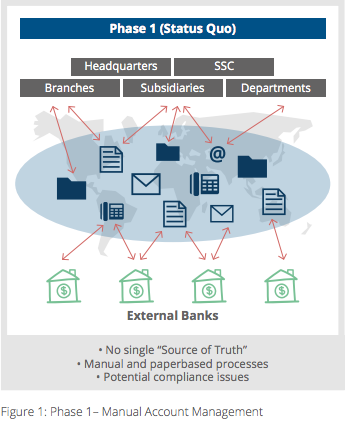
Phase 2 – Bank Account Management
Introducing a web-based SaaS Bank Account Management (BAM) solution provides a clear approach to obtaining the required overview of all banks and bank accounts. Globally, this is a centralised and audit-proof solution, including accurate master data management and electronic workflow based processes for requests to open/close/change bank account activities. The main aspects are as follows:
- Master data and inventory – ensuring an up-to-date data base with real-time access as well as the integration of bank and account related information into various backend (ERP) systems
- Workflow and four-eye-principle – gaining control over streamlined internal processes and authorizations
- Insights into the process landscape – allow a tight monitoring and performance analysis
- Reporting and audit trails – adhering to internal compliance and regulatory guidelines
- Document Management – clear overview and workflow of legally binding and account specific documentation
- Extensibility – the solution can be extended to a full “Partner Management” as well as enhanced by a Bank Fee Management solution to monitor costs and processes.
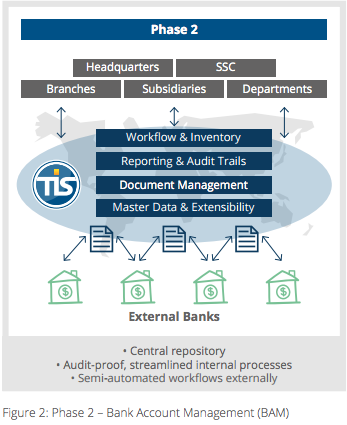
Phase 3 – Electronic Bank Account Management
By moving towards an eBAM solution, additional benefits can be achieved.
The main added-value is a straight-through-process (STP) with participating banks. A set of 15 standardized ISO XML messages can be exchanged on an eBAM platform to cover all main bank account and mandate workflow (opening, changing, closing, confirming).
In addition to the advantages of phase 2 this enables corporates to also streamline and automate the external communication with their banks. The painful and laborintensive paper-based workflow is substituted by electronic communication. Currently, this only works for existing corporate-to-bank relations. The Know-Your-Customer (KYC) process at the beginning of a relationship cannot be accomplished electronically yet. The key eBAM benefits are described in chapter 6 “Best Practice Processes”.
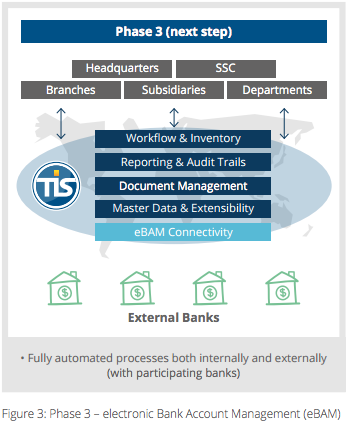
Best practice processes
In our view and based on customer feedback, the new TIS eBAM solution (as shown below in figure 2) currently represents the best practice in the market.
Our model
The TIS model is based on key elements that are part of efficient, low-risk business workflows also embedding current regulatory requirements. Bank accounts can be managed globally, regionally or on division/entity level, with a clear segregation of duties and a customisable notification/alerting functionality:
Best Practice Governance Processes – Master Data & Inventory
Electronic business workflows provide an overview of group-wide requests for opening, changing or closing bank accounts, keeping all master data up to date in a central repository. This also enables real-time access to any related information at the push of a button. All information is made centrally available and integrated with various back-end (ERP) system which require information, such as account data, authorisation rights and daily limits.
While workflows can be automated and delegated to the responsible employees, the solution provides a constant overview of the master data and user permissions on a central level. With the electronic and customisable inventory process local or entity managers can be obligated to confirm the accuracy of the relevant data.
Centrally Managed Authorisations – Workflow & Authorisation
All relevant bank account processes, including authorised signatory details, can be confirmed and monitored in an audit-proof, compliant and customisable way, including a four-eye principle. By guiding and enforcing the approval and change management processes for bank-and account data, internal audit requirements are also met.
Levels of restrictions, signature cards, digitalised signatures and credentials, legally binding country- and bank-specific documentation are all managed and securely stored in a central repository.
Integration
Centralisation of information, documents and processes delivers great benefits; however, eBAM reaches its full potential if all the information can be integrated with the various business systems used in the company, such as ERP or treasury systems. These systems usually depend on – or even are the source of – the information, which is centrally managed. The integration also facilitates the decentralised maintenance and usage of information and at the same, enables complete central governance. Integration scenarios include central approval of accounts which are created within the ERP systems, distribution of signature authorisations or limits as well as account data.
Certified integration capabilities, such as offered by TIS (e.g. SAP certification), ensure that the functionality meets the quality requirements of the vendors and compatibility of the integration scenarios with new releases.
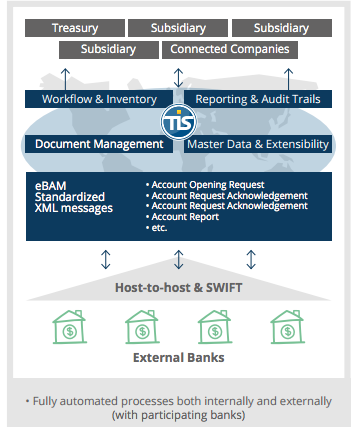
Benefits
The eBAM advantages meet all challenges outlined in chapter 4. This best practice approach can be summarised as follows: Automated, flexible and consistent STP processes for opening, maintenance and closure of bank accounts, providing clear global visibility, accurate accountability
- Audit-proof and highly secure, ISO 20022 compliant and ISO 27001 certified processes, providing a real-time alerting functionality allowing for timely responses to any issues
- Rapid access to up-to-date master data bank (account) information – including mandates – globally and group- wide, enabling efficient workflows across the entire organisation
- Exchange of standardised ISO XML message with the relevant banks
- Complete integration with existing back-office infrastructures is possible
- Fulfillment of both internal and external audit and regulatory requirements
- Enabling the Treasury Department to delegate processes in an audit-proof manner and monitor them centrally. This also frees up time to focus on more strategic topics
- Reduced complexity and increased process automation on all levels lead to significant cost savings across the group
Requirements
Regarding an eBAM implementation strategy, we recommend that some key elements are taken into consideration in order to realise a flexible and customisable multi-bank and multichannel integration:
- Define eBAM in the context of a group-wide bank and bank account strategy, taking advantage of trusted expertise on best practice project implementation.
- Ensure a strong partnership between the involved parties: corporate, banks and solution provider.
- Project management and subject matter expertise: having the right level of expertise at the table in aiding the management of the eBAM Project
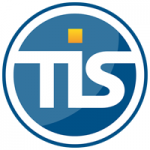 TIS (Treasury Intelligence Solutions)
TIS (Treasury Intelligence Solutions)
Hoe voorkom je faillissement?
| 28-09-2016 | Maarten Verheul |
 Eerst moeten we weten hoe je een naderend faillissement herkent. Als ik zelf een aantal signalen moet noemen dan zijn dat: Liquiditeitsproblemen en zodanig, dat meer dan 60 dagen te laat betaald wordt aan crediteuren. Negatief eigen vermogen en veel personeelsverloop.
Eerst moeten we weten hoe je een naderend faillissement herkent. Als ik zelf een aantal signalen moet noemen dan zijn dat: Liquiditeitsproblemen en zodanig, dat meer dan 60 dagen te laat betaald wordt aan crediteuren. Negatief eigen vermogen en veel personeelsverloop.
Hoe verbeter je de liquiditeit en regel je betalingen?
Dagelijks heb je te maken met het grote spel van CASH. Cash binnen halen en plannen, hoe geef ik het uit en wat moet ik al reserveren? Soms moet je je zelfs wel eens bemoeien met de key accounts van debiteuren om op tijd genoeg geld te hebben voor een betaling die niet later kan zoals salaris, BTW, loonheffing en dergelijke.
Voorkom te alle tijde, dat je zo laat betaald, dat kredietverzekerde crediteuren je bedrijf achterstallig melden bij hun kredietverzekering. De kredietverzekering kan limieten van andere klanten verlagen of zelfs intrekken en dan heb je niet bij één, maar bij meerdere crediteuren cq leveranciers problemen.
Dan kan je nog omzetten naar cash buiten debiteuren zoals Sale Lease back. Nieuwe investeringen alleen nog leasen. Als je een eigen pand hebt ,ook al zit er hypotheek op, kan je met sale lease back van het pand wel eens ineens uit de zorgen zijn.
Ook een financiële reorganisatie kan helpen. Schulden omzetten in aandelen. In mooie woorden heet dat conversie in aandelen. Maar ook leningen omzetten in achtergestelde leningen.
Velen denken waarschijnlijk dat dit onderwerp de ‘ver van mijn bed show’ is, maar dan kan je toch wel eens bedrogen uitkomen. Wat kan je zoal tegen komen in een bedrijf? Niet alleen bezig zijn met korte termijn, maar ook met lange termijn. Rekening houden met worst case scenarios zoals 35% daling in omzet. Strategie aanpassen zoals prijswijzigingen. Als controller moet je ook meedenken met en als een ondernemer.
Alle genoemde zaken en natuurlijk ook de Cash Flow komen aan de orde als je tegen een faillissement aan zit. Belangrijk is om de signalen van een faillissement op te pakken. Te veel aanmaningen, te veel deurwaarders en incassobureaus, in bijzonder beheer bij de bank, dat zijn allemaal signalen. Als je er niets mee doet, dan is het te laat.
Ik ken de signalen. Ik heb ooit een faillissement voorkomen, terug uit bijzonder beheer van de bank naar normaal beheer en 5 jaar later bedrijf succesvol verkocht aan Private Equity.
[separator type=”” size=”” icon=””]
 Maarten Verheul – Treasury Consultant
Maarten Verheul – Treasury Consultant
[button url=”http://www.treasuryxl.com/community/experts/maarten-verheul/” text=”view expert profile” size=”” type=”primary” icon=”” external=”1″]
Blockchain and the Hyperledger project: beyond the hype
| 27-09-2016 | Carlo de Meijer |
 Who is not yet convinced of the potential of blockchain? Here is another example that shows blockchain is beyond the hype. Early September, the Hyperledger Project, a collaborative cross-industry effort to advance blockchain technology, announced that 17 new companies and organisations have joined, bringing the total number of members to more than 80. And expectations are that this number will see a further growth, to beyond 100 at the end of 2016.
Who is not yet convinced of the potential of blockchain? Here is another example that shows blockchain is beyond the hype. Early September, the Hyperledger Project, a collaborative cross-industry effort to advance blockchain technology, announced that 17 new companies and organisations have joined, bringing the total number of members to more than 80. And expectations are that this number will see a further growth, to beyond 100 at the end of 2016.
Let’s have a look how this collaboration platform performed! But first, what is the Hyperledger Project, and what is their goal?
What is the Hyperledger Project?
As they describe themselves on their website:
“The Hyperledger project is an open source collaborative effort created to advance blockchain technology by addressing important features for a cross-industry open standard for distributed ledgers. It is a global collaboration including leaders in finance, banking, Internet of Things, supply chains, manufacturing and Technology. The Linux Foundation hosts Hyperledger Project as a Collaborative Project under the foundation”.
Goal
Main goal is to build an enterprise grade, open source distributed ledger framework and code base to drive blockchain innovation. This should enable organisations to build and run robust industry-specific applications, platforms and hardware systems to support their individual business transactions. All of these innovations will work with an open-source code and distributed ledger architecture.
Through the creation of a framework that integrates different components for different use cases, the consortium is seeking to bring cohesion to a number of independent blockchain efforts that are in the process of developing protocols and standards. The collaboration should help identify and address important features and currently missing requirements for a cross-industry open standard for distributed ledgers.
Codebases
The Hyperledger Project is made up of different codebases donated to the Linux Foundation, contributed by several of its members including IBM, Digital Asset Holdings, Blockstream, Ripple and others to further the Project goals. IBM alone donated 44.000 lines of codes. In total, there are now 160 code contributors (including individuals that may not be working on behalf of any company). It provides a vehicle for companies to collaborate on features.
Members
The Hyperledger Project has gained a lot of industry support in advancing blockchain technology. Since its formal launch in February this year, with original 30 founding members, this number jumped to 80 in a half year time.
New Hyperledger members thereby come from all over the world, including Europe, the US and Asia. They have joined a rapidly growing and diverse group across various industries, including finance, banking, trade finance, supply chain management, manufacturing, technology etc.
The Hyperledger Project has backing from many big corporates. Amongst its members there are a large number of established names from technology giants like IBM, Intel, Cisco, Accenture; to financials with names as JP Morgan, BNY Mellon, ANZ Bank, HSC, Wells Fargo; exchanges such as London Stock Exchange, Deutsche Borse, organisations like SWIFT, CLS, DTCC, Digital Asset Holdings, as well as the bank-backed blockchain consortium R3CEV.
Incentives
Why are they all joining the Hyperledger Project?
There are various motivations and reasons why companies are joining this Project. But in general, Hyperledger is seen by many as being “at the cutting edge of blockchain”. Major institutions are increasingly viewing the Hyperledger Project as a venue for further engagement. International collaboration cross-industry, organised effort plus local experience are thereby looked at as key to ensuring the scalability and the adoption of distributed ledger technology.
For them the Hyperledger Project is uniquely positioned to foster the collaborative approach needed in order to advancing the blockchain ecosystem and promoting blockchain’s extensive application to serve as the future credible infrastructure. They hope, by working with this growing community, to further Hyperledger’s vision and open blockchain development efforts. This by sharing ideas, experiences, expertise and knowledge in an effort to bring blockchain’s emerging technology to market
“A key factor of the project’s success will be member expertise and guidance” – Brian Behlendorf
Recent developments
The Hyperledger project has been rapidly moving forward since the start. Next to the announcement of a growing number of organisations joining their collaborative platform, we have seen a number of interesting developments surrounding the Hyperledger Project.
Election Technical Steering Committee
The governance structure has been further strengthened. The Hyperledger Project recently elected a new Technical Steering Committee (TSC) consisting of 11 members. The members include representatives from names like R3CEV (the other blockchain consortium), Digital Asset Holdings, IBM, London Stock Exchange, and DTTC. The composition of this TSC reflects the importance of these players in the Hyperledger Project, from both a technology as well as a business point of view.
Hyperledger Project and SIBOS Innotribe
Hyperledger Project announced it will sponsor the Innotribe Networking event at Sibos 2016, on Wednesday, September 28. The conference will be held on September 26-29 at PALEXPO in Geneva. As the world’s premier event for financial services, Hyperledger Project is looking forward to discussing open source distributed ledger technology and its potential to transform the industry with leading companies and experts.
Trade Finance Proof of Concept
The Hyperledger Project as well as the bank-backed blockchain consortium R3CEV announced initiatives to develop blockchain prototypes for trade finance innovation on the same day. Both initiatives were exploring how distributed ledger technology could streamline the existing old-fashioned, paper-based and expensive world of trade finance, using letters of credit. They thereby tried to tackle trade financing challenges via this technology.
Hyperledger Project trade finance proof of concept
The Hyperledger Project trade finance proof of concept comprised HSBC, Bank of America Merrill Lynch and IDA (Singapore). Aim of the various parties was to use a blockchain prototype to streamline global trade. The application mirrors a paper-intensive letter of credit (LC), whereby participants could execute a trade deal automatically through a series of digital smart contracts. They thereby used the open source Hyperledger Project blockchain fabric, thereby supported by IBM Research and IBM Global Business Services.
R3CEV blockchain trade finance initiative
R3CEV and 15 of its blockchain consortium members have “successfully” completed two prototypes using distributed ledger technology for smart contracts. The banks designed and used so-called smart contracts on R3’s Corda distributed ledger platform to process accounts receivable (AR) purchase transactions, invoice financing or factoring, and Letter of Credit (LC) transactions.
The involved member banks in the trials include: Barclays, BNP Paribas, Commonwealth Bank of Australia, Danske Bank, ING Bank, Intesa Sanpaolo, Natxis, Nordea, Scotiabank, UBS, UniCredit, US Bank and Wells Fargo.
Competition or collaboration?
HSBC, involved in the Hyperledger Project trade finance PoC, but also member of the bank consortium R3CEV, asked if there was no duplication, and if so, expressed the view that “we will all have to come together, because this has to be industry-led”.
According to HSBC “… now we need to get the technical teams together to understand the pros and cons, because part of what we have learned is also the technical limitations of distributed ledgers, in terms of the number of nodes you can have or the quantity of data you can have on it. So now may be the time to share those and see how we can put our heads together to take this to next level.”
“R3 is a member of the Hyperledger initiative and as such we will continue to explore ways to utilise the code being developed by its open source community in the real-world products we are developing with our consortium members”, said HSBC.
Hyperledger hackaton Amsterdam
ABN Amro, IBM, Holland FinTech and Linux Foundation are to run the first-ever Hyperledger hackaton, inviting coders to develop new financial applications capable of running on distributed ledgers. This one-and-a-half day hackaton will take place on 11-12 October in Amsterdam and is open to developers, tech students and fintech companies that are experimenting with blockchain technologies.
Hyperledger Project to address academic lecture ISITC
Leading members of the Hyperledger blockchain Project will address the European branch of ISITC, the International Securities Association for Institutional Trade Communication. The academic lecture to be held at the London Metropolitan University is intended to give the members an idea of what differentiates the Hyperledger Project from other blockchain projects.
This event that will be held in London is the latest effort by ISITC’s newly formed Blockchain DLT Working Group to lay the foundation for a global effort to standardize distributed ledger technology. The DLT Working Group that emerged earlier this year was invited to create a list of 10 blockchain standards for future development. It has changed its task slightly to focus on a cross-industry framework from which a modified list of benchmarks might eventually emerge. The Working Group prioritised working with other standards bodies and consortia like the Hyperledger Project to minimise overlap.
Hyperledger Project “ Blockchain Explorer “
As more companies like Bank of America and HSBC begin to unveil proofs-of-concept (PoC) using the Hyperledger protocol, a more standardised way to search its data is just part of what it will take to scale. Even beyond building out standards, creating common codes may allow organisations to focus on creating industry-specific blockchain applications.
The Hyperledger Project is now building an open-source tool that will let anyone explore the distributed ledger projects being created by its members. Instead of overlapping efforts and of launching competing open source services, unified effort emerged the blockchain explorers being developed by the likes as IBM, Intel and DTCC. The joint project has been named the “Hyperledger Explorer”. Creating common code will allow organizations to focus on creating industry-specific applications that enhance the value of this technology.
This tool would make it easier to learn about Hyperledger from the inside, while still protecting the privacy. When completed, the Hyperledger Explorer is expected to give Hyperledger developers and non-technical users access to block information, transaction data, network information (such as a list of nodes) and chain codes or transaction families. The Board and the recently newly formed Technical Steering Group will be working on these code proposals in the coming period.
Standardisation
The Hyperledger Project thinks it is still too early to strive for a technical standard for a general purpose inter-chain communication protocol (or even data format). Instead, they would like to encourage the different ongoing proposals to converge towards common architectures and or/even common tech stacks or set of reusable modules. This could serve as the starting point for the development of standard APIs, enabling the inter-chain communication and thus start the discussion around the technical realisation of such a protocol. Parts of this common code could also be reused by other projects, thus contributing to a standardisation of the blockchain technology overtime.

Economist and researcher

